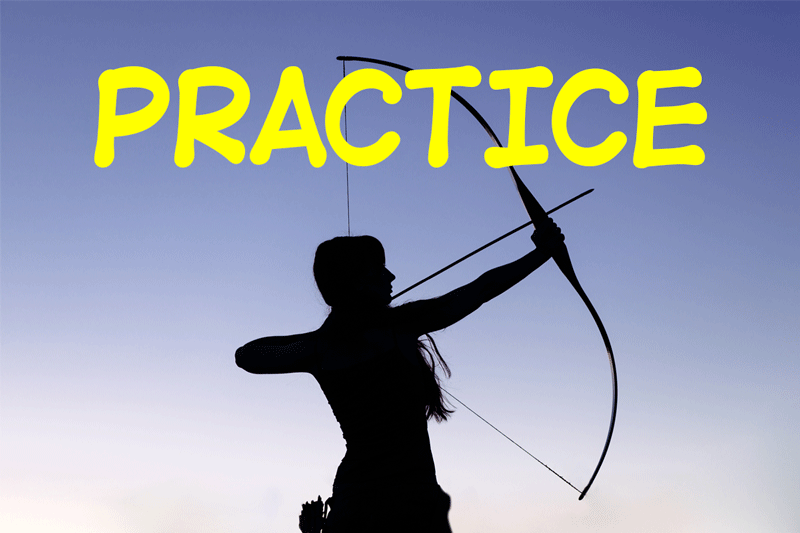Easy Way To Increase Confidence and Decrease Anxiety

There are plenty different ways to look at things. There are plenty of different ways to categorize things. For example, you could put everything in the world in two categories: Things that are edible and things that aren’t. Or you could walk into a supermarket and categorize everything as healthy or unhealthy. There really is no limit, as sorting for things is one of the ways our brains can handle so much information with having blowing a gasket.
Skills And Abilities
One useful distinction is the difference between things that are skills, and things that are abilities. Some things we can learn how to do. Others we can either do them fairly well, or we can’t. For example, there are many things you’ve learned. Things that were once things you couldn’t do, but now you can. There are also plenty of things that you can think of that you can’t do now, but if you had the time and patience to practice, you could get better.
For example, I’ll go out on a limb and make a guess that you can’t juggle three bowling ball pins while riding in circles on a unicycle. But this is also something that if you had enough time and incentive, you could easily learn how. For example, if some researcher decided to prove a point, and offered you a cash prize of a million dollars if you cold learn how to do that (ride a unicycle around in a circle while juggling three bowling ball pins) within six months, no doubt you would be able to learn how in six months.
Abilities Or Laziness?
Sometimes we see somebody doing something, and because simply imagining doing it causes emotional discomfort, we put it in the “ability I don’t have” category in our mind. For example, if we see somebody get up in a restaurant and sing loudly and obnoxiously to their significant other, we would not tend to think of that as a skill to be learned, but rather something we would never do.
We even deceive ourselves on two levels. The first level is deciding we could never do that because it would be too embarrassing, so we don’t even put it into a “skill I could learn” category. But just admitting something is too embarrassing is itself emotional uncomfortable. This makes us skip to another level and say, “Wow, that guys an asshole, I’d never be an asshole like that.”
Our mind is not only very slippery, but it’s quick to hide up any emotional discomfort with ninja-like self deception. We see something we maybe wish we could do, but before we can even allow ourselves to contemplate it as a skill, we cover it up with a couple layers of mental insulation and judge it as “asshole behavior.” This way we get to feel superior to somebody about doing something we’re afraid of doing!
Mental Skills Are Useful

Don’t worry, we’re going to bust into restaurants and start singing. That was just an example of how clever we are when we need to deceive ourselves to protect our ego. In this post we’ll be focusing on a particular mental skill that most people think of as just an ability. But since it’s not an ability that causes us any discomfort, we can talk abut it without worrying about any ego-protective ideas muddying the water.
Mental Grip Strength
Being able to purposely hold a thought in mind is extremely useful. It’s not something we tend to think of as a mental skill. When we think of mental skills, we tend to think of things like mental speed, mental cleverness, or the ability to release negative thoughts. The closest thing to mental grip is the idea of focus. When we focus on something, we usually associate that with studying or paying close attention to something so we can later access the information.
Holding Chosen Thoughts In Mind

But consider the idea of mental focus of being able to choose a thought, any thought, and hold that thought in mind as long as possible. Very similar to how tightly you hold something in your hand. The tighter you squeeze something, the stronger your grip is. Consider the idea of mental grip as your ability to hold a thought in mind despite what is happening around you.
How Is This Helpful?
Consider you are in a social situation. You see an attractive person across the room. You start to walk over to talk to them, but along the way you start to get nervous. You get nervous because your mind is running through all the potential bad outcomes. Meanwhile you’re trying to think of what to say. Meanwhile she is watching you (as are her friends and seemingly everybody else in the place) as you get closer and closer.
Suppose, on the other hand, that the entire walk over there you had one thought in mind so tightly that no other thoughts were possible. No thoughts or worries that would cause anxiety. No concern for what other people might be thinking. What thought? Well, any thought. That’s the point. For the sake of argument, let’s say before you started walking over, you recalled your last successful dating experience.
It could be a lively and fun conversation. It could be an exceptionally long makeout session. Anything. But suppose you held that good experience in mind as you walked over. What would that do to your body language? To your confidence? Normally this doesn’t happen. Most of us think that the thoughts that go through our mind aren’t really under our control.
Practicing Mental Strength
Consider, though, just for a moment, that you could increase the strength of your mental grip just like your physical grip. Sure, it would take practice, but it would be well worth it. Essentially when people say, “be confident,” they mean to hold confident thoughts in mind. When they say things like, “Don’t worry about it,” they are implying you should think of something besides whatever might cause worry.
But for most people, they try it once or twice, and those negative thoughts come creeping back in. Then they conclude that they “just can’t be confident” and give up. Consider that confidence (thinking confident thoughts) and being free from anxiety (not thinking anxiety causing thoughts) is something you can practice. And that the more you practice, the easier it will get.
How To Practice
This will take time, but it will be straightforward and simple. Once you’ve developed a practice routine, (that needs to be just as consistently as any exercise routine to enjoy any benefits) you’ll find you have much more control over your mind.
General Strategy

The basic strategy is to first choose a positive thought. Then you practice focusing on that positive thought for as long as you can, while in many different environments. You’d start first by focusing on that positive thought while in a safe and neutral location, like your room at home without any sounds going on in the background.
The next step would be to practice focusing on that thought in the presence of any interference, like a TV show or while in a conversation with your friends.
The next step would be to practice holding on that thought in a much more difficult environment. Different environments will offer different levels of competition for your thoughts. For example, if you were in a social setting with a lot of attractive people, it will be harder to hold onto a specific thought when making eye contact with an attractive person.
Potential Benefits
If you can choose five positive thoughts to begin with, and build them in so you can call them to mind when you need to, and focus on them above all else, this will be incredibly handy. When you are depressed you can put your mind on positive thoughts. When you are lacking in motivation, you can put your mind on positive thoughts.
When you are taking action that is socially uncomfortable (like walking across the room to start a conversation with an attractive person) you can put your mind on positive thoughts. When you are in a sales conversation, and you need to stay centered, you can keep a few positive thoughts at the ready in case your client gives you any goofy facial expressions.
Choose Five Thoughts

The biggest issue in not thinking negative thoughts is few people ever think about thinking. We think whatever we are thinking and if that happens to good, we’re happy. But then we start thinking negative thoughts and we don’t know what to do. The best defense, they say, is a good offense. From here on out, we highly recommend starting a “positive thinking journal” to get some ideas out on paper.
Start off by thinking of five events that make you feel good when you think about them. These should be recent and they should be real events, not events from movies or TV. It’s best to choose events where you were a primary actor in the event.
For example, if you were standing on the sidewalk staring through the window of a bakery and some guy in a clown suit rode by on his skateboard and handed you a hundred dollar bill, that would certainly be a good memory, but you were a passive player. Try to find five recent events where you were the main player, and it was your actions that made the event a good event.
Five Recommended Categories
The broader the categories you choose, the better these will help you. Try to find one with a financial theme, a friendship theme, a romantic theme, a physical fitness theme and a spiritual or philosophical theme. For now, if you can’t find one in each category, that’s fine. Take your time to find five, regardless of what category they belong to.
Re Create Each Event
The first step is to write out each event in a journal. Either electronically or with a pen and paper, write out the event as is it happened. Use the first person, and be a subjective as you can. The purpose of these is to create positive emotional resources. Take as long as you need to. If you do one per day, that’s perfect. This is definitely a “measure twice, cut once” type of deal.
Put Them On Your Fingers

Once you’ve got them written out and fresh in your memory, start putting them on your fingers. Use whichever hand is dominant. Put each memory on each finger. Close your fist, and stick out your thumb, and read your journal entry, and focus both on the story and your thumb. You’re essentially setting an anchor (more on that here) between the memory and your thumb.
The more effort you put in on the front end, the more it will work when you need it out in the field (whatever that means to you). This will take mental effort. It’s not magic like on TV. Expect to put a lot of mental effort in attaching the memory to your thumb. Do this for each finger. Run through the memory several times for each finger.
Practice In Neutral Locations
Once you’ve got them sort of programmed to your fingers, you can practice recalling these positive memories. You will need to remember to do this. Ideally you want to set a schedule, and do it a few times per day. Give yourself at least five minutes per time. One minute per finger. Stick out the finger (or thumb) from your otherwise closed fist, and purposely recall the positive memory. Close your eyes and make it as real as possible. Purposely jack up the positive emotions as much as you can.
Practice Outside In Semi-Social Situations

Once you have gone through all five events, fingers, and memories in the privacy of your home (or car or anywhere else), you can begin to start doing this in social situations. Find a busy coffee shop, look around the room, and run through each finger. Take the same amount of time, feel each finger, briefly close your eyes and build up those positive emotions and memories.
Practice While Moving Around
Once you’ve practiced while sitting in social situations, practice when you are out walking around. This time do it with your eyes open. If you have spent enough time building in the connection to your fingers and the memories (and the positive emotions) this is a logical next step. Walk somewhere, feel a finger, and recall those positive emotions as much as you can while walking with your eyes open.
It might feel strange at first. You’ll be walking and looking at things while simultaneously remembering past events, but with practice you’ll be able to master it. It’s very easy to soften your gaze, not look at anything in particular, and fully imagine something else.
Practice While Making Eye Contact

When you can get to this point (it will take consistent practice) you will have a very, very, powerful skill. Purposely holding eye contact while purposely keeping a positive memory in mind with as much mental grip as you can will do something incredible.
That image you’re holding in mind will affect your non-verbal communication and body language. You will come across as very congruent, very confident, and very friendly. Whoever you are looking at will feel pretty good, and usually they will naturally reciprocate with equally positive non-verbal communication.
If you hold the positive image in mind strong enough, you will be smiling slightly, both with your eyes and with your mouth. This will make you seem very attractive and charismatic.
Practice While Holding Conversations
Once you master brief eye contact, you can practice holding your positive images while talking to people. This is definitely a skill that will take practice. It’s best to start off doing this while having simple conversations with wait staff. Run through your fingers while waiting in line a Starbucks, for example, and then hold any one image in mind as tightly as you can while placing your order.
The More You Practice The Better You’ll Get

Make no mistake, getting to the point where you can purposely hold positive memories in mind while talking to cute baristas will take time. Give yourself at least a few weeks of daily practice. But once you get there, it will be hard for anybody to not smile and enjoy your presence when you talk to them.
Consider how much better you’d do in all social situations (sales, negotiations, speeches, seductions, etc) if you continue to practice building up your mental grip on purposely positive images.
Experiment With Different Combinations
Once you’ve gotten to the point where you can order your coffee while purposely remembering your last blowjob (for example), you can start to play around with different combinations. For example, if you have a romantic memory on your thumb, and a financial memory on your ring finger, cycle through the both of them, and then pinch those two fingers together right before you start speaking. This is something you can easily do during conversations.
Re Charge While The Other Person Is Talking
This is very powerful, and will take some time. But imagine, for example, you are talking to somebody who’s approval you very much want (job interview, first date, etc.). While they are talking about something that doesn’t take a lot of brainpower to follow, use whatever fingers you need to charge your mind with as much positive energy as you can. So long as you nod in the appropriate places, they will love talking to you.
Journal All Your Experiences
No matter what happens, write everything down. Sometimes you’ll mess up and feel like an idiot. Other times everything will click and you’ll feel like a hero. No matter what, write everything down. The more stuff you write down, the more ideas you’ll come up.
Practice Every Day
Start today, and practice this technique every day. This is totally free, you can use the memories you already have in your head. This simple technique has the capability to completely transform your communication and self confidence. You’ll become more persuasive, more charismatic and outgoing, and much more attractive to your targets.
Learn More

Mind Persuasion has plenty of books and courses designed to help you get much more out of life with much less effort.
Mind Persuasion Books
Mind Persuasion Courses